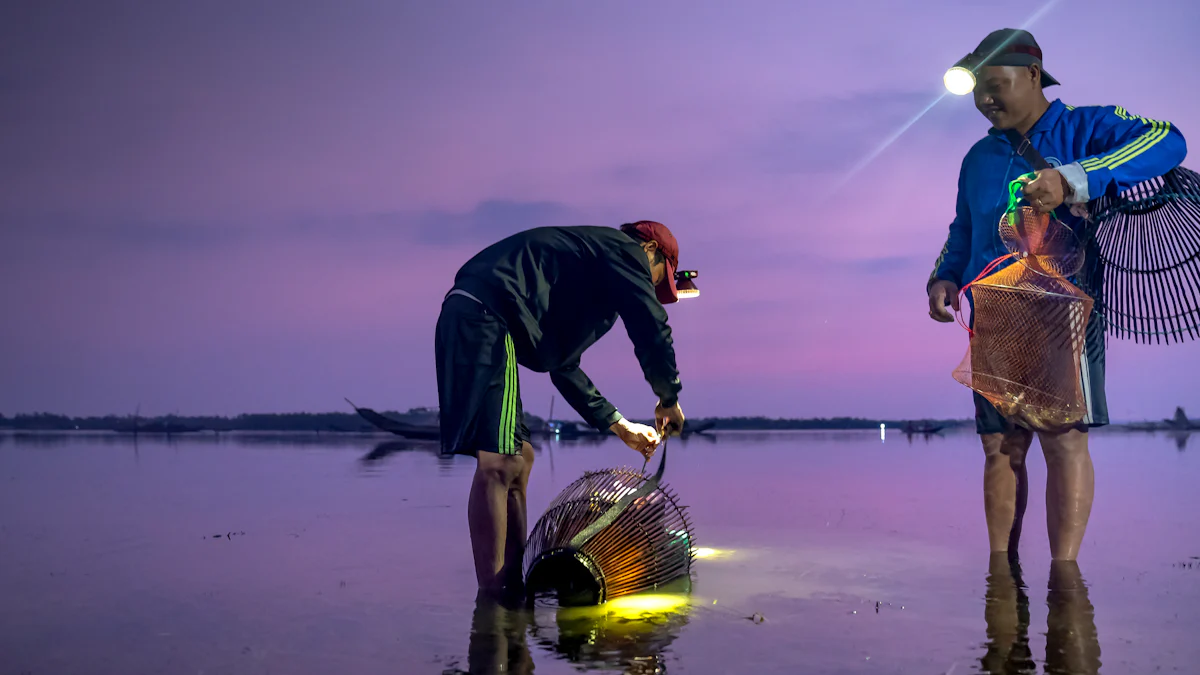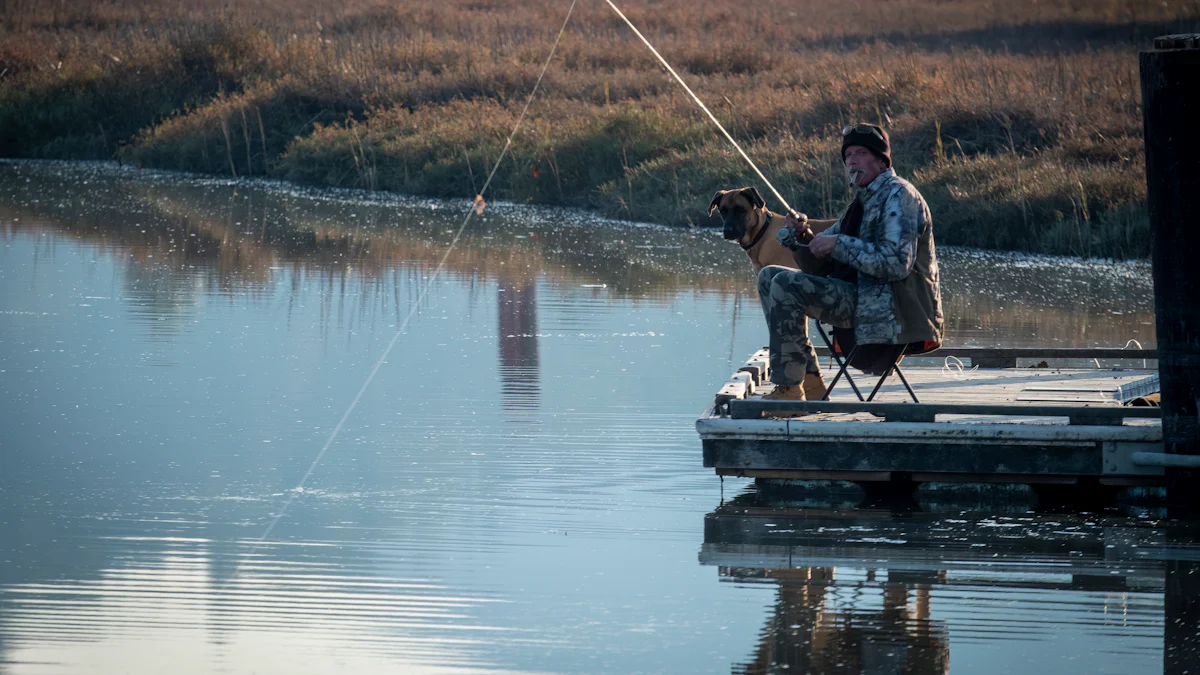Fishing at night or in wet conditions demands reliable lighting. A waterproof headlamp for fishing ensures safety and enhances visibility. In 2025, advancements like the LED rechargeable headlamp offer brighter light and longer battery life. Choosing the right waterproof headlamp depends on durability, comfort, and features tailored to fishing needs.
Key Takeaways
- Pick a waterproof headlamp with IPX7 rating or higher. It will handle heavy rain and water dips.
- Get one with brightness settings you can change. This helps in different fishing spots and won’t scare fish.
- Check and clean your headlamp often. This keeps it waterproof and working well.
Key Features of a Waterproof Headlamp for Fishing

Brightness and Lumens for Night Fishing
Brightness plays a crucial role in night fishing. A waterproof headlamp for fishing should provide sufficient lumens to illuminate the surroundings effectively. Most modern headlamps offer brightness levels ranging from 200 to 1000 lumens. Higher lumens ensure better visibility in complete darkness, helping anglers spot fish movements and navigate safely. However, excessive brightness can disturb fish. Adjustable brightness settings allow users to adapt to different conditions.
Beam Modes and Adjustability for Versatility
Beam modes enhance the versatility of a headlamp. Many models include options like wide beams for close-range tasks and focused beams for long-distance visibility. Adjustable beam angles help direct light precisely where needed. This feature proves especially useful when tying knots, baiting hooks, or scanning the water surface.
Battery Life and Power Options for Long Trips
Long fishing trips demand reliable battery life. Rechargeable headlamps have become popular due to their convenience and eco-friendliness. Some models also support disposable batteries as a backup. A waterproof headlamp for fishing should last at least 8-12 hours on a single charge to ensure uninterrupted use.
Waterproof Rating and IPX Standards
Waterproof ratings determine a headlamp’s ability to withstand water exposure. Look for models with an IPX rating of 6 or higher. An IPX7-rated headlamp can survive immersion in water, making it ideal for fishing in heavy rain or near water bodies.
Durability and Build Quality for Outdoor Use
Fishing environments can be harsh. A durable headlamp with a robust casing resists impacts and wear. Materials like aluminum or reinforced plastic enhance longevity. Shockproof designs further protect the device during accidental drops.
Comfort and Fit for Prolonged Wear
Comfort is essential for extended fishing sessions. Lightweight headlamps with adjustable straps provide a secure fit without causing discomfort. Padding on the straps adds extra comfort, ensuring the headlamp stays in place during active movements.
Types of Waterproof Headlamps for Fishing

LED Headlamps for Brightness and Efficiency
LED headlamps dominate the market due to their superior brightness and energy efficiency. These headlamps produce powerful light while consuming minimal power. Anglers benefit from their long-lasting performance, especially during extended fishing trips. LED technology also offers consistent illumination, ensuring clear visibility in low-light conditions. Many models include adjustable brightness levels, allowing users to adapt to various fishing environments.
Rechargeable vs. Battery-Powered Models
Rechargeable headlamps have gained popularity for their convenience and eco-friendliness. They eliminate the need for disposable batteries, reducing waste and long-term costs. However, battery-powered models remain a reliable option for anglers who prefer carrying spare batteries as a backup. Choosing between these two depends on personal preference and the duration of fishing trips. Rechargeable models suit short outings, while battery-powered ones excel in remote locations without charging facilities.
Red Light Mode for Night Vision and Fish Safety
Red light mode is a valuable feature for night fishing. It preserves night vision, allowing anglers to see clearly without straining their eyes. This mode also minimizes disturbance to fish, as red light is less likely to spook them. Many waterproof headlamps for fishing include this feature, making them ideal for stealthy operations in the dark.
Lightweight vs. Heavy-Duty Headlamps
Lightweight headlamps prioritize comfort and portability. They suit anglers who value ease of movement during fishing. Heavy-duty headlamps, on the other hand, offer enhanced durability and higher waterproof ratings. These models withstand harsh conditions, making them suitable for rugged environments. Selecting the right type depends on the fishing location and individual needs.
Practical Tips for Using a Waterproof Headlamp for Fishing
Adjusting Beam Angle for Optimal Illumination
Adjusting the beam angle ensures proper lighting during fishing activities. Anglers should tilt the headlamp downward when tying knots or preparing bait. This adjustment prevents light from scattering unnecessarily. For scanning the water surface, a forward-facing beam works best. Many headlamps include pivoting mechanisms, allowing users to change the angle effortlessly. Testing the beam angle before heading out ensures the light covers the desired area.
Using Red Light Mode to Avoid Spooking Fish
Red light mode is essential for stealthy night fishing. Fish are less sensitive to red light, making it ideal for maintaining a calm environment. Anglers can use this mode when checking gear or moving around the fishing spot. Switching to red light mode also helps preserve night vision, reducing eye strain. Most waterproof headlamps for fishing include a dedicated button for quick access to this feature.
Battery-Saving Techniques for Extended Use
Conserving battery life is crucial during long fishing trips. Anglers should use lower brightness settings when full illumination is unnecessary. Turning off the headlamp during breaks prevents unnecessary power drain. Rechargeable models often include power-saving modes, which automatically adjust brightness to extend usage. Carrying a backup power source ensures the headlamp remains functional throughout the trip.
Cleaning and Drying Your Headlamp After Fishing
Proper maintenance extends the lifespan of a headlamp. After fishing, users should rinse the headlamp with fresh water to remove dirt and salt. A soft cloth works well for drying the device. Special attention should be given to the waterproof seals, ensuring no moisture remains trapped. Storing the headlamp in a dry, cool place prevents damage and keeps it ready for the next adventure.
Maintenance and Testing of Waterproof Headlamps
Inspecting Waterproof Seals and Casings
Regular inspection of waterproof seals ensures the headlamp remains water-resistant. Anglers should check for cracks, wear, or dirt around the seals. Damaged seals compromise the headlamp’s ability to withstand water exposure. Cleaning the seals with a soft cloth removes debris that might affect their performance. Applying a silicone-based lubricant can help maintain flexibility and prevent drying out. Users should also examine the casing for any visible damage. Scratches or dents may weaken the structure, reducing its durability. A quick visual check before each trip ensures the headlamp stays reliable in wet conditions.
Testing Battery Life and Charging Capabilities
Testing the battery life of a headlamp helps avoid unexpected power loss during fishing trips. Users should fully charge the headlamp and monitor how long it lasts under normal usage. This test provides a clear idea of the battery’s condition. Rechargeable models should be checked for proper charging functionality. Faulty charging ports or cables can lead to incomplete charges. For battery-powered models, anglers should test spare batteries to ensure they work as expected. Keeping a record of battery performance helps identify when replacements or repairs are necessary.
Proper Storage Between Fishing Trips
Proper storage extends the lifespan of a waterproof headlamp. After each trip, users should clean and dry the headlamp thoroughly. Storing it in a cool, dry place prevents moisture buildup and corrosion. A protective case adds an extra layer of safety, shielding the device from dust and impacts. Avoiding direct sunlight or extreme temperatures helps preserve the materials and battery life. Organizing the headlamp with its accessories, such as spare batteries or charging cables, ensures everything is ready for the next outing. Consistent care keeps the headlamp in optimal condition for future use.
Selecting the right waterproof headlamp enhances fishing safety and success. Features like adjustable brightness, durable materials, and red light modes cater to diverse needs. Anglers should prioritize models that balance quality and functionality. Investing in a reliable headlamp ensures better visibility and comfort, making every fishing trip in 2025 more enjoyable and productive.
FAQ
How do you choose the right waterproof rating for a fishing headlamp?
Select a headlamp with an IPX7 or higher rating. This ensures it can handle heavy rain or accidental water immersion during fishing trips.
Can a rechargeable headlamp work in remote fishing locations?
Yes, rechargeable headlamps work well if paired with a portable power bank. Carrying a backup ensures uninterrupted lighting in areas without charging facilities.
What is the best way to clean a waterproof headlamp?
Rinse the headlamp with fresh water after use. Dry it with a soft cloth and inspect the seals to ensure no moisture remains trapped.
Post time: Jan-15-2025
 fannie@nbtorch.com
fannie@nbtorch.com +0086-0574-28909873
+0086-0574-28909873





